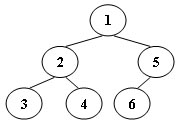An inorder binary tree traversal can be implemented in a non-recursive way with a stack. For example, suppose that when a 6-node binary tree (with the keys numbered from 1 to 6) is traversed, the stack operations are: push(1); push(2); push(3); pop(); pop(); push(4); pop(); pop(); push(5); push(6); pop(); pop(). Then a unique binary tree (shown in Figure 1) can be generated from this sequence of operations. Your task is to give the postorder traversal sequence of this tree.

Figure 1
Input Specification:
Each input file contains one test case. For each case, the first line contains a positive integer N (≤) which is the total number of nodes in a tree (and hence the nodes are numbered from 1 to N). Then 2 lines follow, each describes a stack operation in the format: "Push X" where X is the index of the node being pushed onto the stack; or "Pop" meaning to pop one node from the stack.
Output Specification:
For each test case, print the postorder traversal sequence of the corresponding tree in one line. A solution is guaranteed to exist. All the numbers must be separated by exactly one space, and there must be no extra space at the end of the line.
Sample Input:
6
Push 1
Push 2
Push 3
Pop
Pop
Push 4
Pop
Pop
Push 5
Push 6
Pop
Pop
Sample Output:
3 4 2 6 5 1
解析:先建树,在后后序遍历
push的顺序就是先序遍历的顺序
pop的顺序就是中序的顺序
#include<iostream> #include<stack> #include<string> using namespace std; int pre[40],in[40],post[40];//以此为先序,中序,后序的输入序列 int n; stack<int> st;//栈 struct node { int data; node* left; node* right; }; node* create(int prel, int prer, int inl, int inr)//通过先序,中序建树 { if(prel>prer) return NULL; node* root = new node; root ->data = pre[prel]; int k=0; for(k = inl;k<=inr;k++) { if(in[k]==pre[prel]) break; } //k指示了中序遍历的根节点的位置 int numleft = k - inl; root ->left = create(prel+1,prel+numleft,inl,k-1); root->right = create(prel+numleft+1,prer,k+1,inr); return root; } int num=0; void postorder(node* root)//后序遍历 { if(root == NULL) return; postorder(root->left); postorder(root->right); printf("%d",root->data); num++; if(num<n) printf(" "); } int main() { scanf("%d",&n); string str; int x, preindex=0, inindex=0; for(int i=0;i<2*n;i++) { cin>>str; if(!str.compare("Push"))//如果str和push相等,s.compare("Push")返回0 { scanf("%d",&x); pre[preindex++] = x;//输入先序遍历 st.push(x); } else { int temp = st.top(); st.pop(); in[inindex++] = temp;//中序遍历 } } node* root = create(0,n-1,0,n-1); postorder(root); return 0; }